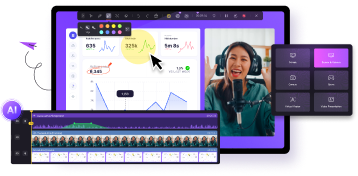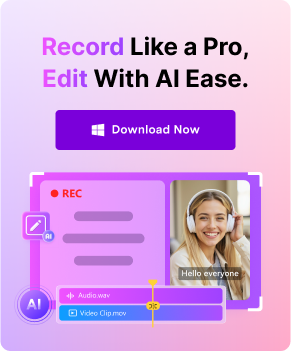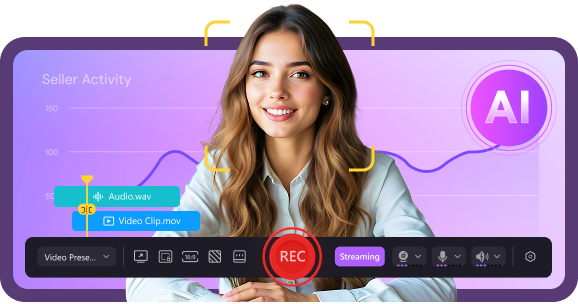Today, video formats are key in eLearning. They support many teaching methods and meet different learning styles. This guide looks at eight unique eLearning video types. Each one helps learners in special ways. You will learn about instructor-led videos, interactive videos, and animated videos, among others. These videos address a wide range of educational needs.
Key Takeaways
- Instructor-led training video is one of the eight types of eLearning videos discussed.
- Animated Training Videos include various styles like stop-motion, whiteboard animation, and moving infographics.
- How-to training videos, also known as demonstration videos, are popular for step-by-step guides on YouTube.
- Interactive Training Videos are highly engaging but require significant time to create.
- The revenue in the eLearning market is projected to reach USD 4.73 billion in 2023, emphasizing the growing importance of video in eLearning.
In this article
Part 1: Introduction to eLearning Videos

eLearning videos have changed the way we learn by adding visuals to lessons. By 2022, they will make up 82% of all internet traffic. This is up from 73% in 2016. This shows more people want to learn with videos now. In our tech-savvy era, eLearning videos are essential for keeping up with educational trends.
Edgar Dale's cone of learning shows we remember 10% of what we read and 20% of what we hear. We recall 30% of what we see. But, we remember even more, 50%, when we see and hear it. Doing things ourselves? We remember 70%. And if we're really involved, it goes up to 90%. eLearning videos help us remember better. They work great on platforms like vimeo elearning.
Video courses, like those from TalentLibrary™, are good for your budget and time. They help a lot with soft skills and understanding big ideas. Studies show video training helps people remember things for up to a month. Cisco found that learners get 32% better at complex skills with videos.
About 65% of people learn best by seeing. Videos make hard ideas easier to get. They are key for training in areas like compliance and sales. Using videos often means getting a good return on your teaching efforts.
Videos let learners watch content again for better understanding. This method is better than just trying to remember a lecture. Adding special tools to videos makes learning even more engaging and useful.
Using eLearning videos today is very important. Platforms like vimeo elearning let teachers make content that is fun and helps all kinds of learners.
Part 2: Talking Head Videos
Talking head videos are a great way to deliver elearning content. They feature an expert or educator talking right at the camera. This style helps create a personal connection with viewers. It makes the learning experience better.
Benefits of Using Talking Head Videos
Talking head videos are known for being cost-effective and easy to make. They suit different learning styles. By adding a human touch, they make content more fun and easy to relate to. Using facial expressions and hand gestures keeps viewers interested. These videos are good for breaking down complex topics into smaller parts.
Key tips include using good lighting, a clear script, and a professional setting. Additionally:
- They are cost-effective because they need minimal gear.
- It's easy to use them in various video types like explainer and training videos.
- They allow a personal touch through body language and facial expressions.
Example: TED Talks
TED Talks are a prime example of talking head elearning videos. Speakers engage the audience with powerful talks. They use clear scripts and deliver effectively. TED Talks show how to share complex ideas clearly and with impact. They highlight the strengths of talking head videos in elearning.
Here’s a comparison of some key aspects:
| Feature | Talking Head Videos | Other Video Types |
| Cost | Low | High |
| Engagement | High due to personal connection | Medium |
| Ease of Creation | Simple setup | Complex setup |
| Microlearning Suitability | Ideal | Varies |
Part 3: Interview Videos
Interview videos are now a top choice for online learning. They bring a personal feel to eLearning, making it more engaging. By featuring talks with experts and leaders, they add great value.
Why Use Interview Videos in eLearning?
These videos are special because they show many views. They keep lessons interesting and useful. Recent stats reveal:
- Video is the favorite learning format online, attracting countless users.
- In Q4 of 2021, more than half of internet users aged 16-24 watched elearning videos.
- For the 25-34 and 35-44 age groups, the numbers are also impressive at 47% and 45%, respectively.
Interview videos in eLearning feel personal and boost interaction. They are more favored than scripted content. Emotional impact is big, especially with customer stories in training.
This kind of video feels real. It shares firsthand experiences and advice effectively.
Example: FranklinCovey OnLeadership Series
The FranklinCovey OnLeadership series is a prime example. It features talks with industry leaders, offering deep insights. By adding expert interviews, FranklinCovey raises the bar in eLearning. This series shows the power of interactive learning.
Part 4: Slide Presentation Videos

Slide presentation videos are key in elearning. They offer an easy way to share knowledge. By using visual aids like slides and narration, they make hard topics simple. This helps people understand and remember the information better.
These elearning materials are very flexible. For example, turning PowerPoint slides into interactive lessons changes how we learn. Making the content more engaging is important. But, PowerPoint can be a bit straight-forward. So, adding interactive parts is crucial to keep learners focused.
Lots of people prefer watching videos.YouTube gets 5 billion views a day! Videos grab attention much better than text, says Forrester Research. Using videos for elearning can really help people learn better. Emarketer found that most videos are watched on phones. This means we should make videos easy to watch on mobile.
Tools like iSpring Suite are great for educational videos. They let you add narration, make slides move, and put in video clips. These options meet the growing needs of teachers and trainers. They make creating interactive videos easier. Even with possible technical issues in PowerPoint, using engaging materials improves learning.
In short, making good use of PowerPoint elearning changes how we teach. It can make learning more interactive and meaningful. With more and more people watching educational videos, their importance in elearning grows daily.
Part 5: Animation Videos for eLearning
Animation videos are becoming very popular in eLearning. They make hard ideas easy to understand with fun pictures. More companies and schools are using animation for eLearning now. This has increased the need for good eLearning animation. Studios like F. Learning Studio make about 150 minutes of animation every month.
F. Learning Studio has been making custom animated eLearning videos for over eight years. These videos don't just grab learners' attention; they also make emotional connections. These connections are key for truly learning something. Now, let's look at why these videos are great and an example of one.
Advantages of Animated Videos
Animated eLearning videos offer many good things:
- Visualization of Complex Concepts: They help learners see and get tricky ideas easier than just words.
- Engagement and Retention: Animated videos are really good at keeping learners interested. They are nine times better at this than texts.
- Customization: Animators can make content that fits exactly what learners need to know.
Example: Headspace
Headspace is a great example of using animated videos in eLearning. It teaches how to meditate and be mindful with easy-to-watch videos. This way, learning becomes easier, and people remember better. Headspace's approach makes hard topics simple and fun.
Vyond is changing how eLearning animations are made, with AI-helped video creation. 65% of Fortune 500 companies enjoy using Vyond's huge library and features. It simplifies making high-quality videos for teaching.
Adding animated videos in eLearning makes learning more fun, interactive, and effective. This approach can really change how we learn for the better.
Part 6: Whiteboard Explainer Videos
Whiteboard explainer videos are getting more popular for learning online. They use animations that look like someone is drawing on a whiteboard. This style helps make complex ideas or processes easy to understand.
They are great for those making learning materials who want to grab learners' attention.
What Are Whiteboard Explainer Videos?
These videos are animated in a style that looks hand-drawn, similar to a classroom whiteboard. Tools like VideoScribe and PowToon make creating these videos easy. They are useful in many areas like marketing and educating customers.
Using custom whiteboard explainer videos can boost information retention by 15%.
Adding voice-overs to these animations makes them even more effective. This combination helps people learn better. Making a whiteboard video is pretty quick, usually taking about 10 to 13 days in total.
- Typical cost: $5,000 to $15,000 per minute
- Engagement increase: 40% during live narration
- Sales rate increase: Up to 50% for some industries
Many top tools for creating eLearning courses let you add videos easily. One video about insurance policies even raised sales by 50%. This shows how effective these videos are at explaining things.
Example: The History of Marriage
"The History of Marriage" is a great example of these videos' power. It uses fun animations and narration to explain how marriage has changed over time. This format works well for marketing in tech, healthcare, and finance by making tough topics fun.
Part 7: Creating Effective Demonstration Videos

Demonstration elearning videos make learning by seeing and doing much easier. They show key steps one at a time. This is crucial for tech and crafts, where seeing how it's done helps a lot.
Research shows that videos help people remember better than text alone. About 65% of us are visual learners. This is why tutorial videos are so good for learning.
Yet, our focus is short. Keep videos under 3 minutes to keep viewers watching. Start with a quick 1-3 minute intro. Then, if needed, go deep for 5-15 minutes.
It's important to include subtitles and transcripts for everyone. Screencasts are great for teaching software. Richard Mayer's work tells us that multimedia helps learning. It shows well-made videos are truly effective.
| Type of eLearning Video | Ideal Length | Best Practices |
| Cost | 1-3 minutes | Keep it concise and engaging. |
| Overview | 2-5 minutes | Provide a high-level summary of key concepts. |
| Deep Dive | 5-15 minutes | Include detailed, thorough explanations. |
| Instructional/How-To | Up to 3 minutes | Deliver clear and concise step-by-step directions. |
A 2014 study found that video quality affects how much students engage. In 2021, Noetel, M. and others also found videos enhance learning. Experts like Brame, C.J., and Mayer, R.E. offer tips for great videos.
In the end, tutorials in elearning help everyone. They make hard ideas easier and more fun to learn.
Part 8: Webinar Videos
Webinars are a great way to learn, mixing live talks with the ease of watching anytime. They work like traditional classes but are more flexible. This makes them popular with both organizations and learners.
Benefits of Live Webinars
Live webinars let instructors and learners talk in real time. This creates a lively and interactive way to learn. They offer instant feedback and customized content by watching how participants react.
For example, the "Cybersecurity: the balance of assurance and insurance" webinar is set for July 2, 2024. It shows how live webinars are perfect for discussing current topics deeply.
Advantages of Recorded Webinars
Recorded webinars can be watched anytime, which is super handy. They let you go back to review things you need more help with. This helps everyone learn better, no matter their schedule.
Take the "The Applied Mechanical Stabilization Design Method for Unpaved Roads" webinar on April 30, 2024, as an example. It shows that these webinars can be long-lasting learning tools. Making content just for these formats really helps keep learners interested.
Bonus:DemoCreator Empowers the Creation of Engaging eLearning Videos


If you’re looking to make your eLearning videos more engaging, DemoCreator is the perfect tool. With its simple interface and powerful features, you can create professional-quality videos that keep learners interested and help them understand complex topics easily.
Here’s how DemoCreator works for different types of eLearning videos:
- Screen Recording: Ideal for software tutorials, DemoCreator captures your screen in high quality with features like click highlights and keystroke visualization.
- Interactive Videos: Add quizzes or annotations directly to your videos to make them more engaging and test learner understanding.
- Explainer Videos: Use animation and visual effects to break down complex concepts and make them easy to follow.
- Talking-Head Videos: Record yourself explaining topics while presenting slides or demos for a personal touch.
- Microlearning: Create short, focused videos that deliver key information quickly and effectively.
Why Choose DemoCreator?
- Easy to Use: Perfect for beginners and pros.
- Customizable: Add effects, annotations, and branding.
- Time-Saving: Pre-built templates and fast editing tools.
DemoCreator makes it simple to create any type of eLearning video. Try it out to see how it can transform your content into something learners love!
FAQs
-
What are the different types of eLearning videos?
eLearning videos come in many styles. You'll find talking head videos, interview videos, and slide presentation videos. There are also animated videos, whiteboard explainer videos, demonstration videos, and webinars. Each one helps learners in different ways. They make learning from direct info sharing to fun, interactive experiences.
-
How do talking head videos enhance eLearning?
Talking head videos show an expert talking to the camera. This makes learning feel more personal. They help the viewer feel a stronger connection. A well-known example is TED Talks.
-
What are the benefits of using interview videos in eLearning?
Interview videos feature experts offering different views. This keeps the content fresh and engaging. It's like FranklinCovey's OnLeadership series that makes learning more dynamic.
-
Why are slide presentation videos popular in educational content?
Slide presentation videos mix slides with talking. They make hard topics easy to understand. This format is great for school and work learning.
-
What advantages do animated videos offer in eLearning?
Animated videos use fun graphics and stories. They are great for explaining hard ideas. They grab your attention and make it simpler, like Headspace does.



